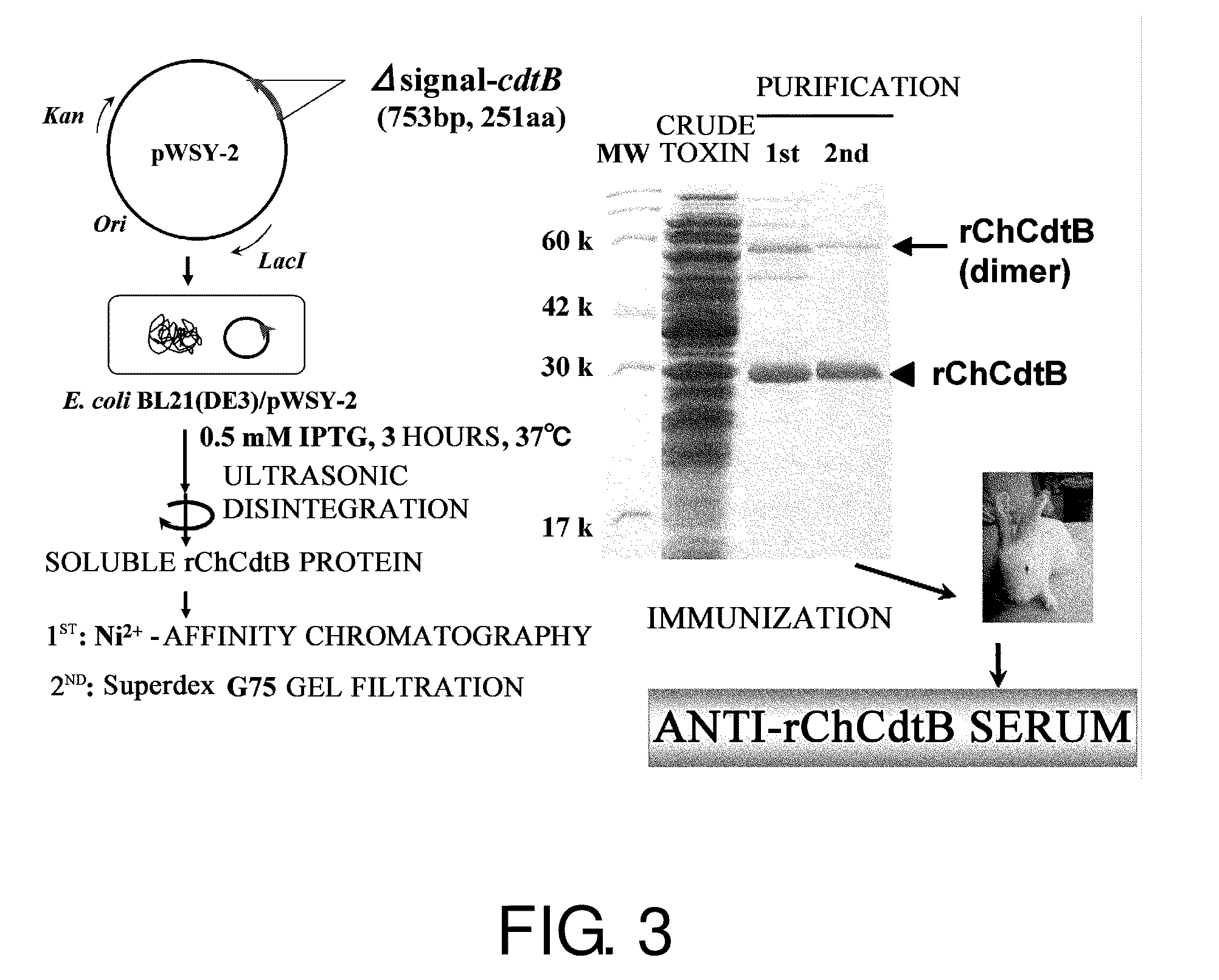Detection of bacteria belonging to the genus campylobacter by targeting cytolethal distending toxin
a technology of cytolethal distending toxin and detection of bacteria, which is applied in the field of detection of bacteria belonging to the genus campylobacter, can solve the problems of difficult rapid identification, long time-consuming cultivation test, and difficult identification of i>campylobacter i>bacteria including isolation and identification, etc., and achieves rapid detection of campylobacter bacteria.
- Summary
- Abstract
- Description
- Claims
- Application Information
AI Technical Summary
Benefits of technology
Problems solved by technology
Method used
Image
Examples
example 1
Sequencing of the cdt Genes of the Thai-Derived C. hyointestinalis Ch022 Strain
[0169]The genomic gene was isolated from the Ch022 strain by a conventional method.
[0170]100 ng of the isolated Ch022 genomic gene was subjected to PCR using an Ex Taq PCR kit (TaKaRa) and common primers capable of amplifying the cdtB gene of C. jejuni, C. coli, and C. fetus (FIG. 1). The concentration of each primer was 0.5 μM. The primers were mixed with 5 μl of 10× Ex Taq buffer, 4 μl of dNTPs, and 1.25 U of Ex Taq. The volume was adjusted to 50 μl with sterile water. The PCR mixture was subjected to PCR with a program consisting of 30 cycles of 94° C. for 30 seconds, 50° C. for 30 seconds, and 72° C. for 30 seconds. The resulting PCR product was electrophoresed on a 2% agarose gel, and it was stained with ethidium bromide. After destaining, the amplification bands were observed under UV light (FIG. 1).
[0171]The obtained 720-bp band specifically amplified was purified by a conventional method, and sequ...
example 2
Preparation of Recombinant CdtB Protein (Ch-rCdtB) of the Thai-Derived C. hyointestinalis Ch022 Strain
[0174]The cdtB gene of the Thai-derived C. hyointestinalis Ch022 strain, in which amino acids 1-17 of CdtB which is predicted to be the CdtB signal sequence was removed, was amplified by PCR and cloned into the pET-28(a) plasmid vector to obtain pWSY-2, a recombinant clone of the cdtB gene of the Thai-derived C. hyointestinalis Ch022 strain.
[0175]BL-21(DE3) which is an E. coli for recombinant protein expression (Novagen) was transformed with pWSY-2. The resulting clone was cultured on a large scale in 600 ml of LB broth containing 20 μg / ml kanamycin, and then expression of the recombinant protein (Ch-rCdtB) was induced with 0.5 mM IPTG at 37° C. for three hours. The Ch-rCdtB-expressing E. coli was disintegrated by ultrasonication. The protein was affinity-purified with Ni-Chelating Sepharose (GE Healthcare), and further purified by gel filtration with Superdex 75 (GE Healthcare) (FI...
example 3
Preparation of an Antibody Against CdtB of the Thai-Derived C. Hyointestinalis Ch022 Strain
[0176]250 μg of purified Ch-rCdtB was combined with an equal volume of Freund's complete adjuvant. The resulting emersion was administered subcutaneously and intramuscularly to rabbits (kbs: NZW). Then, starting four weeks after the first administration, the rabbits were immunized five times in total with an emersion containing 250 μg of purified Ch-rCdtB and an equal volume of incomplete Freund's adjuvant at two-week intervals for about eight weeks. An antiserum was thus prepared, and then tested for its titer and specificity by the gel double diffusion method and Western blotting (FIG. 4).
[0177]The titer of the anti-Ch-rCdtB antiserum was estimated to be 1:64 by the gel double diffusion method. Meanwhile, there was no precipitate line between the antibody and C. jejuni rCdtB. Thus, it was revealed that C. hyointestinalis CdtB was immunologically distinct from C. jejuni CdtB (FIG. 4C). Wester...
PUM
| Property | Measurement | Unit |
|---|---|---|
| pH | aaaaa | aaaaa |
| temperature | aaaaa | aaaaa |
| temperature | aaaaa | aaaaa |
Abstract
Description
Claims
Application Information
 Login to View More
Login to View More - R&D
- Intellectual Property
- Life Sciences
- Materials
- Tech Scout
- Unparalleled Data Quality
- Higher Quality Content
- 60% Fewer Hallucinations
Browse by: Latest US Patents, China's latest patents, Technical Efficacy Thesaurus, Application Domain, Technology Topic, Popular Technical Reports.
© 2025 PatSnap. All rights reserved.Legal|Privacy policy|Modern Slavery Act Transparency Statement|Sitemap|About US| Contact US: help@patsnap.com



